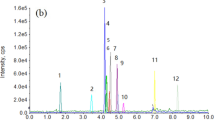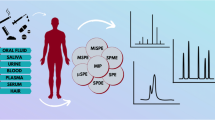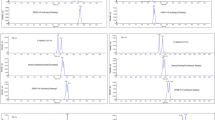Abstract
An anti-ketamine molecularly imprinted polymer (MIP) was synthesized and used as the sorbent in a solid-phase extraction protocol to isolate ketamine and norketamine from human hair extracts prior to LC-MS/MS analysis. Under optimised conditions, the MIP was capable of selectively rebinding ketamine, a licensed anaesthetic that is widely misused as a recreational drug, with an apparent binding capacity of 0.13 μg ketamine per mg polymer. The limit of detection (LOD) and lower limit of quantification (LLOQ) for both ketamine and norketamine were 0.1 ng/mg hair and 0.2 ng/mg hair, respectively, when 10 mg hair were analysed. The method was linear from 0.1 to 10 ng/mg hair, with correlation coefficients (R 2) of better than 0.99 for both ketamine and norketamine. Recoveries from hair samples spiked with ketamine and norketamine at a concentration of 50 ng/mg were 86% and 88%, respectively. The method showed good intra- and interday precisions (<5%) for both analytes. Minimal matrix effects were observed during the LC-MS/MS analysis of ketamine (ion suppression −6.8%) and norketamine (ion enhancement +0.2%). Results for forensic case samples demonstrated that the method successfully detected ketamine and norketamine concentrations in hair samples with analyte concentrations ranging from 0.2 to 5.7 ng/mg and from 0.1 to 1.2 ng/mg, respectively.

Illustration of the ketamine-imprinted polymer and its recognition sites.




Similar content being viewed by others
References
Ahmed SN, Petchkovsky L (1980) Abuse of ketamine. Br J Psychiatry 137:303
Siegel RK (1978) Phencyclidine and ketamine intoxication: a study of four populations of recreational users. NIDA Res Monogr 21:119–147
Rabben T, Skjelbred P, Oye I (1999) Prolonged analgesic effect of ketamine, an N-methyl-D-aspartate receptor inhibitor, in patients with chronic pain. J Pharmacol Exp Ther 289(2):1060–1066
Dalgarno PJ, Shewan D (1996) Illicit use of ketamine in Scotland. J Psychoactive Drugs 28(2):191–199
Jansen KL (1993) Non-medical use of ketamine. BMJ 306(6878):601–602
EMCDDA (20002) Report on the risk assessment of ketamine in the framework of the joint action on new synthetic drugs. European Monitoring Centre for Drugs and Drugs Addiction. Office for Official Publications of the European Communities, Luxembourg
Degenhardt L, Dunn M (2008) The epidemiology of GHB and ketamine use in an Australian household survey. Int J Drug Policy 19(4):311–316
Lua AC, Lin HR, Tseng YT, Hu AR, Yeh PC (2003) Profiles of urine samples from participants at rave party in Taiwan: prevalence of ketamine and MDMA abuse. Forensic Sci Int 136(1–3):47–51
Zhao C, Liu Z, Zhao D, Liu Y, Liang J, Tang Y, Liu Z, Zheng J (2004) Drug abuse in China. Ann N Y Acad Sci 1025:439–445
Leong HS, Tan NL, Lui CP, Lee TK (2005) Evaluation of ketamine abuse using hair analysis: concentration trends in a Singapore population. J Anal Toxicol 29(5):314–318
Harun N, Anderson RA, Miller EI (2009) Validation of an enzyme-linked immunosorbent assay screening method and a liquid chromatography–tandem mass spectrometry confirmation method for the identification and quantification of ketamine and norketamine in urine samples from Malaysia. J Anal Toxicol 33(6):310–321
US Department of Justice (2004) Ketamine: intelligence bulletin (Product No. 2004-L0424-007). US Department of Justice, Washington
Jackson ARW, Jackson JM (2008) Forensic science, 2nd edn. Pearson Education, Harlow
Cooper G, Moeller M, Kronstrand R (2008) Current status of accreditation for drug testing in hair. Forensic Sci Int 176(1):9–12
Wu YH, Lin KL, Chen SC, Chang YZ (2008) Integration of GC/EI-MS and GC/NCI-MS for simultaneous quantitative determination of opiates, amphetamines, MDMA, ketamine, and metabolites in human hair. J Chromatogr B 870(2):192–202
Lin YH, Lee MR, Lee RJ, Ko WK, Wu SM (2007) Hair analysis for methamphetamine, ketamine, morphine and codeine by cation-selective exhaustive injection and sweeping micellar electrokinetic chromatography. J Chromatogr A 1145(1–2):234–240
Xiang P, Shen M, Zhuo X (2006) Hair analysis for ketamine and its metabolites. Forensic Sci Int 162(1–3):131–134
Gentili S, Cornetta M, Macchia T (2004) Rapid screening procedure based on headspace solid-phase microextraction and gas chromatography for the detection of many recreational drugs in hair. J Chromatogr B 801:289–296
Ariffin MM, Miller EI, Cormack PAG, Anderson RA (2007) Molecularly imprinted solid-phase extraction of diazepam and its metabolites from hair samples. Anal Chem 79(1):256–262
Anderson RA, Ariffin MM, Cormack PAG, Miller EI (2008) Comparison of molecularly imprinted solid-phase extraction (MISPE) with classical solid-phase extraction (SPE) for the detection of benzodiazepines in post-mortem hair samples. Forensic Sci Int 74(1):40–46
Chapuis F, Pichon V, Hennion M-C (2004) Molecularly imprinted polymers: development and applications of new selective solid-phase extraction materials. LG-GC Europe 17:408–417
Stevenson D (1999) Molecularly imprinted polymer for solid-phase extraction. Trends Anal Chem 18:154–158
Masqué N, Marcé RM, Borrull F (2001) Molecularly imprinted polymers: new tailor-made materials for selective solid phase extraction. Trends Anal Chem 20:477–486
Vlatakis G, Andersson LI, Muller R, Mosbach K (1993) Drug assay using antibody mimics made by molecular imprinting. Nature 361(6413):645–647
Miller EI, Wylie F, Oliver J (2008) Simultaneous detection and quantification of amphetamines, diazepam and its metabolites, cocaine and its metabolites, and opiates in hair by LC-ESI-MS-MS using single extraction method. J Anal Toxicol 32:457–469
Ariffin MM, Anderson RA (2006) LC/MS/MS analysis of quaternary ammonium drugs and herbicides in whole blood. J Chromatogr B 842:91–97
Al-Asmari AI, Anderson RA (2007) Quantification of opioids and their metabolites in autopsy blood by liquid chromatography-tandem mass spectrometry. J Anal Toxicol 1:394–408
Matuszewski BK, Constanzer ML, Chavez-Eng CM (2003) Strategies for the assessment of matrix effect in quantitative bioanalytical methods based on HPLC-MS/MS. Anal Chem 75(13):3019–3030
Navarro-Villoslada F, Vicente BS, Moreno-Bondi MC (2004) Application of multivariate analysis to the screening of molecularly imprinted polymers for bisphenol A. Anal Chim Acta 504:149–162
Song S, Shi X, Li R, Lin Z, Wu A, Zhang D (2008) Extraction of chlorpromazine with a new molecularly imprinted polymer. Process Biochem 43:1209–1214
Zhu Q, Wang L, Wu S, Wasswa J, Gu X, Tang J (2009) Selectivity of molecularly imprinted solid phase extraction for sterol compounds. Food Chem 113(2):608–615
Simon R, Collins ME, Spivak DA (2007) Shape selectivity versus functional group pre-organization in molecularly imprinted polymers. Anal Chim Acta 591(1):7–16
Moller K, Crescenzi C, Nilsson U (2004) Determination of a flame retardant hydrolysis product in human urine by SPE and LC-MS. Comparison of molecularly imprinted solid-phase extraction with a mixed-mode anion exchanger. Anal Bioanal Chem 378(1):197–204
Baggiani C, Giovannoli C, Anfossi L, Tozzi C (2001) Molecularly imprinted solid-phase extraction sorbent for the clean-up of chlorinated phenoxyacids from aqueous samples. J Chromatogr A 938(1–2):35–44
UNODC (2009) Guidance for the validation of analytical methodology and calibration of equipment used for testing of illicit drugs in seized materials and biological specimens (ST/NAR/41). UNODC, Vienna
Acknowledgement
This study was supported by a scholarship from the Department of Public Service and The Ministry of Health, Malaysia.
Author information
Authors and Affiliations
Corresponding author
Rights and permissions
About this article
Cite this article
Harun, N., Anderson, R.A. & Cormack, P.A.G. Analysis of ketamine and norketamine in hair samples using molecularly imprinted solid-phase extraction (MISPE) and liquid chromatography–tandem mass spectrometry (LC-MS/MS). Anal Bioanal Chem 396, 2449–2459 (2010). https://doi.org/10.1007/s00216-009-3404-6
Received:
Revised:
Accepted:
Published:
Issue Date:
DOI: https://doi.org/10.1007/s00216-009-3404-6




